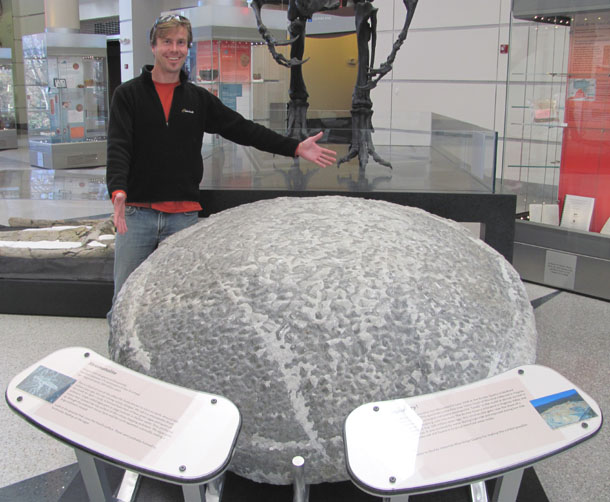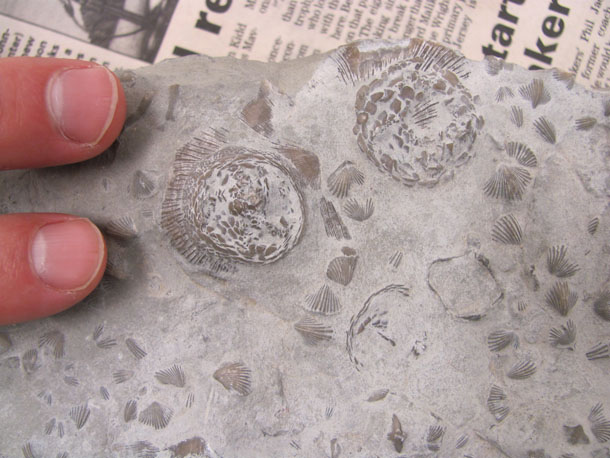30 November 2010
Scenes from the Virginia Museum of Natural History
Posted by Callan Bentley
Over Thanksgiving, my fiancee and I went down to Asheville, North Carolina, where she has family. On our way back up, we made a detour to go back to DC via Martinsville, Virginia, where the Virginia Museum of Natural History is located. I especially wanted to link up there with Alton ‘Butch’ Dooley, the curator of paleontology, and have him show me around. It was my great luck that Butch and his wife Bret were available on a post-holiday Saturday afternoon to walk Lily and I around the museum. I was really impressed with the facility. It is a real gem architecturally and scientifically, and Virginia should be proud to have funded it. I was really impressed, though to be honest I wasn’t expecting anything located in Martinsville to be worth much. It’s a stunning building, airy and light, with world-class specimens on display. I was really impressed! Even though the museum has been through several rounds of budget cuts, it’s still a jewel in the Commonwealth’s crown.
Here’s a Allosaurus cast from Wyoming, all decked out for the holidays:

Just in front of the Allosaurus is the famous Boxley stromatolite, a stunning, huge monster of a stromatolite, though not as threatening as some.

Behind the scenes, in Butch’s lab, we got to see lycopod trees, dinosaur femurs, whale skulls, little tiny reptiles that glided on extended ribs, and these cool edrioasteroids, an encrusting variety of echinoderm that I had never heard of before.

They are growing on brachiopods. This is part of a new Ordovician Seas exhibit that Butch and his colleagues are working on for next year. A closer look:

Lastly, take a peek at “Clawd,” a reconstruction of a giant ground sloth as unearthed at Saltville, Virginia (a big Pleistocene mammal fossil deposit):
If you’re ever in Martinsville (and why would you be in Martinsville; let’s not kid ourselves)… Scratch that. Tell you what: If you’re ever on an itinerary which would take an extra hour or less to detour to Martinsville (much more realistic), then I recommend you do it. Virginia’s amazing natural history museum may not be conveniently located, but it is a stunning repository of cool stuff. I recommend you check it out.



 Callan Bentley is Associate Professor of Geology at Piedmont Virginia Community College in Charlottesville, Virginia. He is a Fellow of the Geological Society of America. For his work on this blog, the National Association of Geoscience Teachers recognized him with the James Shea Award. He has also won the Outstanding Faculty Award from the State Council on Higher Education in Virginia, and the Biggs Award for Excellence in Geoscience Teaching from the Geoscience Education Division of the Geological Society of America. In previous years, Callan served as a contributing editor at EARTH magazine, President of the Geological Society of Washington and President the Geo2YC division of NAGT.
Callan Bentley is Associate Professor of Geology at Piedmont Virginia Community College in Charlottesville, Virginia. He is a Fellow of the Geological Society of America. For his work on this blog, the National Association of Geoscience Teachers recognized him with the James Shea Award. He has also won the Outstanding Faculty Award from the State Council on Higher Education in Virginia, and the Biggs Award for Excellence in Geoscience Teaching from the Geoscience Education Division of the Geological Society of America. In previous years, Callan served as a contributing editor at EARTH magazine, President of the Geological Society of Washington and President the Geo2YC division of NAGT.
We were thrilled to have you and Lily visit the museum, Callan. Please stop by again when you’re down this way!
One note: the edrioasteroids are actually on loan from the geology department at Earlham College. We’re going to do some prep work on the specimens, make molds of it, and then include it in the upcoming Ordovician exhibit.
There is an eerily similar giant ground sloth at Mastodon State Historic Site in Missouri. See for yourself… http://farm1.static.flickr.com/231/454757356_bfa9396dd6_z.jpg
They must have been cousins.
Uncanny.
So is the Boxley stromatolite notable mainly for its size, or is there something else special about it? I had never heard of it beofre you posted the picture (FaceBook?) a couple of days ago. Whatever the case, its gorgeous.
It’s (a) huge and (b) weathered out in its full three-dimensional form, unlike a lot of stromatolites which we only see in cross-section or plan-view outcrops. Here’s some background on the source (Boxley is a company with a quarry and an interest in science education):
http://web.me.com/dooleyclan/Site_2/Blog/Entries/2008/6/30_Boxley_stromatolite.html
In addition to the points Callan mentioned, the overall shape is a bit unusual as well. The low dome and thickened rim suggests that the stromatolite formed under protected conditions, rather than in a shallow offshore environment like the other stromatolites in the same unit.
I published a paper in the museum’s journal about the specimen that’s available online: http://www.vmnh.net/store.cfm?itemID=77
The blog archives about the stromatolite are at: http://web.me.com/dooleyclan/Site_2/Boxley_Stromatolite_Archive.html
[…] Lily and I drove down from Washington, DC, to Asheville, North Carolina. I already mentioned the detour we made on the way back home. But on the way down, I made us take a little detour to go and gigapan the Konnarock […]
Please come back and spend more time visiting Martinsville. Dr. James Beard, who also works at the Virginia Museum of Natural History, takes our local class of students who are training to become Virginia Master Naturalists on field trips that feature local outcroppings. There are fairystones that can be picked up off the ground in nearby Bassett, plenty of other things for entertaining other family members. We have a great network of trails along the Smith River and through the city of Martinsville.
[…] This post was mentioned on Twitter by Am Geophysical Union, David Orr. David Orr said: Mountain Beltway visits the VA Museum of Nat History http://bit.ly/dJngHP […]
[…] other thing that I noticed during my visit last weekend to the Virginia Museum of Natural History in Martinsville, Virginia, was this fold. As soon as I saw it, I squealed “Oooh! That’s […]
[…] November didn’t let up on my crazy travel schedule. I drove out to Pittsburg for the Fine International Conference on Gigapixel Imaging for Science, and I went deer hunting with my brother in western Virginia. The month also includes Thanksgiving, and on our way down to visit Lily’s family in Asheville, North Carolina, we check out the Konnarock Formation. On the way back, we visited the Virginia Museum of Natural History. […]